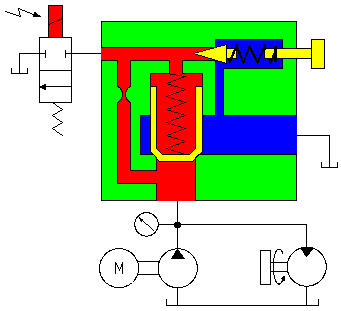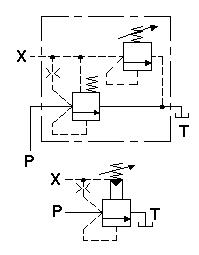The pilot operated pressure relief valve


The pilot operated pressure relief valve
is applied in systems with a considerable amount of flow.
It's task is to limit the pressure in the system on an acceptable value.
Description: The pilot valve
is adjusted at 150 bar. The pressure below the main valve is equal to the pressure above the main valve, for example 100 bar (determined by the load on the hydraulic motor).
The spring on the main valve (about 1 to 5 bar) keeps the valve in the closed position.
As long as the pressure in the system does not increase the adjusted pressure, the pump flow goes to the hydraulic motor. When the hydraulic motor is overloaded, the pressure will increase and the pilot valve will open. From that moment on the pressure above the main valve is limited on 150 bar.
However, the pump flow cannot be drained by the small throttle in the by-pass canal, so the pressure below the main valve will increase with the spring pressure of about 1 to 5 bar (the pressure below the main valve will increase to 151...155 bar). Then the main valve opens and the majority of the pump flow will be drained by the main valve.

The symbol
of the pilot operated pressure relief valve according to NEN3348 and ISO 1219 (complete and simplified)


